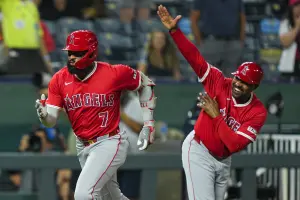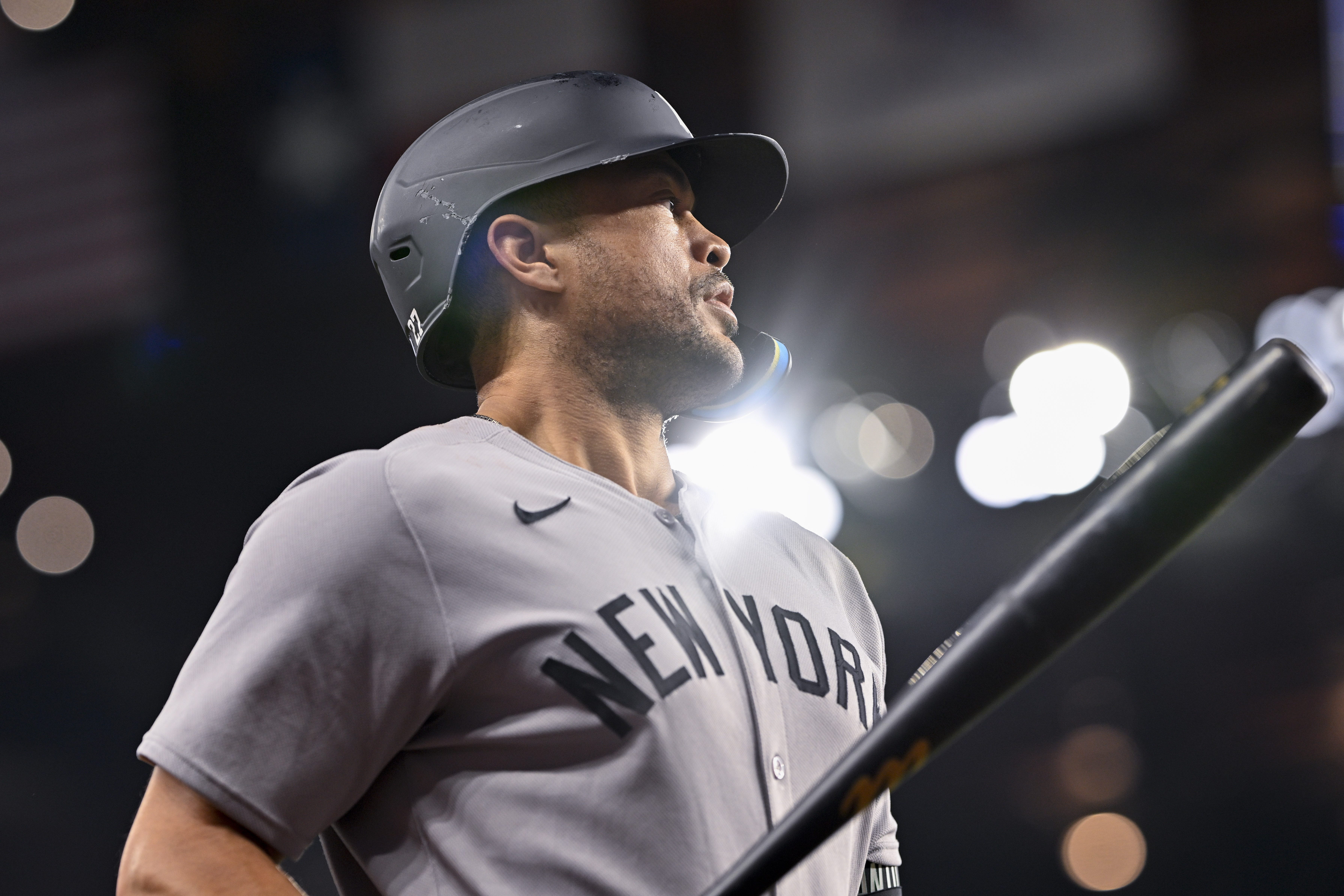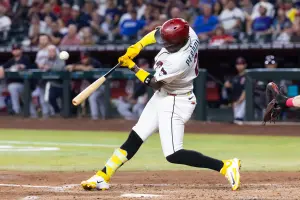
(*) LINEUP OUTLOOK: Batting leadoff; Atlanta swaps two; more
Although this column mostly focuses on players moving up or down a lineup, along with the potential impact from a fantasy standpoint, a bit of a switch will appear this week. It's never too early for planning strategies for next year, and with pitchers no longer batting, plus rules making stealing bases easier, does targeting a leadoff hitter on a bad team pay off for runs scored? Atlanta ranks third in runs scored this season and Texas leads the majors, so how does getting their respective ninth spot batters stack up against the player with the most stolen bases? Speaking of Atlanta, Brian Snitker changed two hitters' spots in the lineup in a clean swap. Does it actually enhance both players' fantasy outlooks? Last, but not least, some hitting stream options for 12-team formats with eyes on next week's scoring period.
Process for Runs Scored
Without looking, it feels like a leadoff hitter should produce more runs per plate appearances than someone batting last in his lineup. However, team context matters, especially for an underappreciated category like runs. Esteury Ruiz leads the majors with 39 stolen bases, which sits eight above his total runs scored for the season (31). It's not all his fault, as he's an electric factory when he reaches base but is at the mercy of his teammates to drive him in. He's accrued 268 plate appearances while leading off for the A's and scored 26 runs from said lineup position, which averages out at a run per 11 plate appearances, even with his tremendous speed upside.
Unlock all of our insights on your way to a fantasy title! See what our season-long coverage offers and then subscribe to BaseballHQ.com.
Since Texas and Atlanta rank in the top three in runs scored this season, their lineups turn over often, making up for fewer plate appearances for their ninth slot hitters, who have been very productive this year for runs scored. Leody Taveras had a hot streak last year, rose up to near the top of the batting order, and then cratered. With Marcus Semien and Corey Seager firmly entrenched as the top two hitters in the lineup, Taveras can flourish while hitting ninth.
He's scored 24 runs over 144 plate appearances while batting last, with five doubles, a triple, six home runs, 19 RBI, and three stolen bases. His .256/.313/.444 slash line does not leap off the page, but he's scoring a run every six plate appearances, almost double the production in that metric than that of Ruiz, who hits first.
In terms of draft capital, throwing Michael Harris ll into the conversation feels a bit trite, but he's flourishing while hitting last, calling himself a "second leadoff" hitter in his team's deep lineup. He's hit ninth in 32 games, logging 119 plate appearances with 17 runs, four doubles, six home runs, 17 RBI, three steals, and a .279/.311/.478 slash line. He scores a run every seven plate appearances while batting last.
Taking this one step further, here are the teams' plate appearances this year by lineup spot, with the runs per plate appearance rates above applied:
- Oakland leadoff hitters: 354 plate appearances, 32 runs
- Atlanta hitters batting ninth: 278 plate appearances, 39 runs
- Texas hitters batting ninth: 290 plate appearances, 35 runs
Even with the added volume, Ruiz would finish behind both Harris ll and Taveras in these prorated numbers. Past practice in drafts can cloud our process, as many take into account how many runs teams should score and stack their players no matter where they hit in the preseason. There's no denying how valuable Ruiz has been from a stolen base standpoint, but his counting statistics must receive help from other places on fantasy rosters. Where a hitter bats remains important, but who he plays with sometimes matters more.
Atlanta's "Switch"
On June 15, a slight tweak in the batting order occurred with Ozzie Albies moving into second in the lineup while Matt Olson moved down to fifth. Albies was already often hitting second when facing southpaws, but a potential permanent change may be on the horizon. It's a very small sample size, but both players have benefited from the adjustment by manager Brian Snitker.
Over his last five games, Albies has produced a .391/.417/.696 slash line with three runs, a double, two home runs, and nine RBI. This puts his on-base plus slugging percentage (OPS) at a robust 1.112 in this limited sample. He entered gameplay at the time of this writing tied for ninth in home runs (17) and tied for tenth in total bases (141), but this move will boost his runs scored total along with providing more stolen base opportunities. He can tag along on double steals with Ronald Acuña Jr., something Olson did not partake in.
Speaking of the power hitting first baseman, he's tied for third in the majors with 21 home runs, and tied for sixth in RBI (47). He will trade some runs scored for RBI, which enhances his overall value in fantasy batting fifth. Again, noting it's a very small sample, he's 6-for-20 (.300) with two doubles, three home runs, and seven RBI, posting a 1.183 OPS through his first five starts batting fifth this season.
Although Albies may not drive in as many runs hitting second, his RBI opportunities may not fall off as much as one would anticipate. Harris ll has been on a heater, recording a .460 batting average (23-for-50) with 10 runs, four doubles, four home runs, and 12 RBI since June 7, spanning 13 starts. He's raised his average by 86 points and his OPS by 214 points during this stretch. As if this lineup needed more upside, these changes may produce a strong second half of results for Atlanta batters.
Hitting Stream Options for June 26-through-July 2
- Kerry Carpenter (OF, DET): Not only does he get a seven-game week, the Tigers will play four games in Texas and three at Coors Field, with six right-handed starting pitchers projected. He's hit five home runs in 112 plate appearances facing right-handed pitching and has been hot since his return. Over his last 46 plate appearances, he's scored seven runs with two home runs, five RBI, and a .372/.391/.581 slash line. Also of interest, Andy Ibañez for those in deeper formats (five extra-base hits his last 40 plate appearances with seven RBI).
- Daniel Vogelbach (UT, NYM): After personal time off, he's bounced back with two home runs and seven RBI over his last 18 plate appearances through his last five games. In this span, he's produced a .412 isolated power and a .412/.444/.824 slash. He could face six right-handed starters next week with four games against Milwaukee and three versus San Francisco.
- Mickey Moniak (OF, LAA): For those seeking runs, he leads off against right-handed pitching and through his last 80 plate appearances against them owns a .325 average with 11 runs, six home runs, and 15 RBI, fueling a 1.025 OPS.
Remain ahead of the competition using all the great resources at BaseballHQ. Until next time, stay safe and be well.








